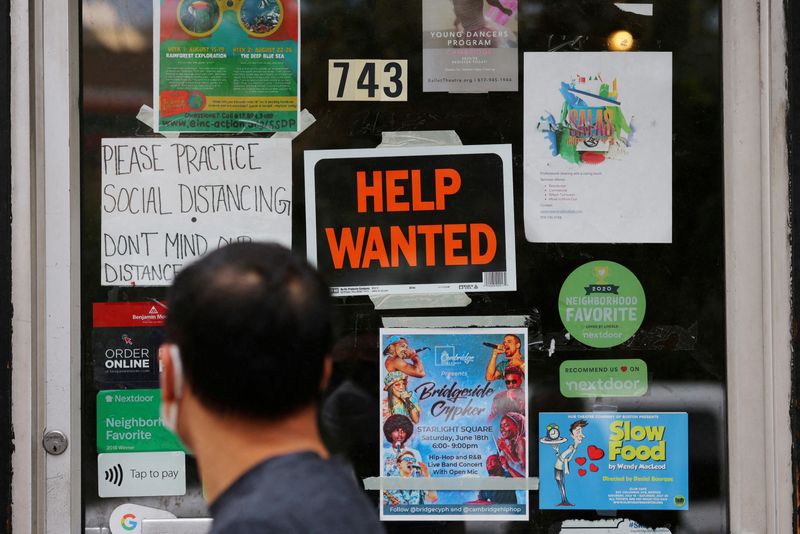By Lucia Mutikani
WASHINGTON (Reuters) - U.S. job growth slowed moderately in September while the unemployment rate dropped to 3.5%, pointing to a tight labor market which keeps the Federal Reserve on its aggressive monetary policy tightening campaign for a while.
Though the decline in the jobless rate from 3.7% in August was partly because of people leaving the workforce, fewer Americans worked part-time for economic reasons last month, the Labor Department's closely watched employment report showed on Friday. The labor market continues to show resilience despite the Fed's stiff interest rate hikes, which are slowing demand.
"The labor market continues to run stubbornly hot," said Michael Feroli, chief U.S. economist at JPMorgan (NYSE:JPM) in New York. "The super-tight hiring conditions are generating wage and nominal income growth that is inconsistent with getting inflation back down to a more acceptable rate."
Nonfarm payrolls increased by 263,000 jobs last month after rising by an unrevised 315,000 in August, the survey of establishments showed. While that was the lowest since April 2021, job gains exceeded the monthly average of 167,000 in the 2010s. Job growth has averaged 420,000 per month this year.
Economists polled by Reuters had forecast 250,000 jobs added, with estimates ranging from as low as 127,000 to as high as 375,000. The unemployment rate was seen unchanged at 3.7%.
President Joe Biden said the job gains were "an encouraging sign that we are transitioning to stable, steady growth."
The employment report suggested the economy was not in recession despite gross domestic product contracting in the first half. But risks of a downturn next year are mounting as the Fed ramps up its fight against inflation.
The U.S. central bank has hiked its policy rate from near-zero at the beginning of this year to the current range of 3.00% to 3.25%. September's consumer price report next Thursday will help policymakers to assess their progress in taming inflation ahead of their Nov. 1-2 policy meeting.
Last month's broad increase in employment was led by the leisure and hospitality industry, where payrolls increased by 83,000 jobs. The bulk of the gains were at restaurants and bars. Still, leisure and hospitality employment remains 1.1 million jobs below its pre-pandemic level.
Healthcare added 60,000 jobs in September, returning employment in the sector back to its pre-pandemic level. Employment in the professional and business services industry increased by 46,000 jobs. Manufacturing added 22,000 jobs, while construction created 19,000 positions, despite the housing market being hammered by the higher borrowing costs.
There were also gains in wholesale trade employment, but the financial activities industry shed 8,000 jobs, while the transportation and warehousing sector lost 7,900. Retail employment fell by 1,100 jobs. Government payrolls dropped by 25,000 jobs.
"The economy did not fall into recession the first half of 2022, nor did it fall into recession in the third quarter," said Brian Bethune, an economics professor at Boston College. "Yet, the inveterate recession predictors just keep moving their recession date into the future."
Stocks on Wall Street were trading lower. The dollar rose against a basket of currencies. U.S. Treasury prices fell.
WOMEN LEAVE WORKFORCE
Financial markets have almost priced-in a fourth 75-basis points rate increase at next month's Fed meeting, according to CME's FedWatch Tool.
The labor market's resilience has been attributed to a reluctance by businesses to lay off workers following difficulties hiring in the past year as the COVID-19 pandemic forced some people out of the workforce, partly due to prolonged illness caused by the virus.
While government data this week showed job openings dropped by 1.1 million, the largest decline since April 2020, to 10.1 million on the last day of August, there are still 4 million more vacancies than there are unemployed Americans. An Institute for Supply Management survey on Wednesday also showed several services industries reporting labor shortages in September.
Economists say businesses have been backfilling open positions as they struggled to expand headcount to match increased demand for their products, driving up job gains.
The household survey from which the unemployment rate is derived showed 57,000 people left the labor force last month, which helped to pull down the unemployment rate. About 390,000 women aged 20 and over dropped out.
As a result, the labor force participation rate, or the proportion of working-age Americans who have a job or are looking for one, slipped to 62.3% from 62.4% in August. It is 1.1 percentage points below its February 2020 level.
The participation rate for women 20 years or over fell to 58.0% from 58.4% in August.
Other details of the household survey were strong. Household employment increased strongly and the number of people working part-time for economic reasons dropped 306,000 to 3.8 million.
That led to a broader measure of unemployment, which includes people who want to work but have given up searching and those working part-time because they cannot find full-time employment, declining to 6.7% from 7.0% in August.
With the labor market still tight, wage gains remained solid. Average hourly earnings increased 0.3% after a similar rise in August. That lowered the annual increase in wages to 5.0% from 5.2% in August. The average workweek was unchanged at 34.5 hours for the fourth straight month.
Though earnings growth has slowed from a peak of 5.6% in March, the Atlanta Fed's wage tracker, viewed as a more reliable measure because it controls for compositional effects like skill level, occupation and geography, is running at 6.7%.
By any measure, current wage growth is inconsistent with the Fed's 2.0% inflation target.

"The good news from a growth perspective is that the strength of the labor market is keeping the aggregate household paycheck in positive territory, even taking into account elevated inflation," said Eric Winograd, a senior economist at AllianceBernstein (NYSE:AB) in New York.
"That's an important argument in favor of a soft or at least a softish economic landing still being possible."